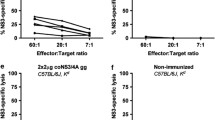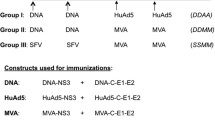Abstract
Repeated injections of hepatitis D antigen (HDAg) delivered either as a recombinant protein, or expressed from a DNA vaccine elicited no (or only very low) antibody responses in inbred mouse strains. Codelivery of oligonucleotides (ODN) with immune-stimulating sequences (ISS) with the protein antigen, or ISS in DNA vaccines (encoding HDAg) did not overcome the low intrinsic immunogenicity of this small viral antigen for B cells. In contrast, codelivery of immunogenic, heterologous proteins (either mixed to recombinant HDAg as recombinant proteins, or fused to HDAg sequences as chimeric antigens expressed from DNA vaccines) provided specific, CD4+ T cell-dependent “help” that supported efficient priming of antibody responses to HDAg. Chimeric proteins in which selected HDAg fragments were fused in frame with immunogenic, heterologous protein fragments produced by DNA vaccines allowed the mapping of antibody-binding HDAg domains of the viral antigen. The described approach thus facilitates induction of serum antibody responses against native viral antigens with low immunogenicity for B cells






Similar content being viewed by others
Abbreviations
- eGFP :
-
Enhanced green fluorescence protein
- ELISA :
-
Enzyme-linked immunosorbent assay
- hCMV-IE :
-
Human cytomegalovirus immediate early
- HBcAg :
-
Hepatitis B core antigen
- HBsAg :
-
Hepatitis B surface antigen
- HBV :
-
Hepatitis B virus
- HDV :
-
Hepatitis D virus
- HDAg :
-
Hepatitis D or δ antigen
- L-HDAg :
-
Large p27 HDAg
- S-HDAg :
-
Small p24 HDAg
- hsp :
-
Heat shock protein
- ISS :
-
Immune-stimulating (CpG-containing) sequence
- mAb :
-
Monoclonal antibody
- ODN :
-
Oligodeoxynucleotide
- OVA :
-
Ovalbumin
- PAGE :
-
Polyacrylamide gel electrophoresis
- SDS :
-
Sodium dodecyl sulfate
References
Bergmann KF, Cote PJ, Moriarty A, Gerin JL (1989) Hepatitis δ antigen. Antigenic structure and humoral immune response. J Immunol 143:3714–3721
Modahl LE, Lai MM (2000) Hepatitis delta virus: the molecular basis of laboratory diagnosis. Crit Rev Clin Lab Sci 37:45–92
Mauch C, Grimm C, Meckel S, Wands JR, Blum HE, Roggendorf M, Geissler M (2001) Induction of cytotoxic T lymphocyte responses against hepatitis delta virus antigens which protect against tumor formation in mice. Vaccine 20:170–180
Polo JM, Lim B, Govindarajan S, Lai MM (1995) Replication of hepatitis delta virus RNA in mice after intramuscular injection of plasmid DNA. J Virol 69:5203–5207
Huang YH, Wu JC, Tao MH, Syu WJ, Hsu SC, Chi WK, Chang FY, Lee SD (2000) DNA-Based immunization produces Th1 immune responses to hepatitis delta virus in a mouse model. Hepatology 32:104–110
Fiedler M, Lu M, Siegel F, Whipple J, Roggendorf M (2001) Immunization of woodchucks (Marmota monax) with hepatitis delta virus DNA vaccine. Vaccine 19:4618–4626
Fiedler M, Roggendorf M (2001) Vaccination against hepatitis delta virus infection: studies in the woodchuck (Marmota monax) model. Intervirology 44:154–161
Huang YH, Wu JC, Hsu SC, Syu WJ (2003) Varied immunity generated in mice by DNA vaccines with large and small hepatitis delta antigens. J Virol 77:12980–12985
Krieg AM (2002) CpG motifs in bacterial DNA and their immune effects. Annu Rev Immunol 20:709–760
Gurunathan S, Klinman DM, Seder RA (2000) DNA vaccines: immunology, application and optimization. Annu Rev Immunol 18:927–974
Kontgen F, Suss G, Stewart C, Steinmetz M, Bluethmann H (1993) Targeted disruption of the MHC class II Aα gene in C57BL/6 mice. Int Immunol 5:957–964
Okabe M, Ikawa M, Kominami K, Nakanishi T, Nishimune Y (1997) ‘Green mice’ as a source of ubiquitous green cells. FEBS Lett 407:313–319
Kawakami N, Sakane N, Nishizawa F, Iwao M, Fukada SI, Tsujikawa K, Kohama Y, Ikawa M, Okabe M, Yamamoto H (1999) Green fluorescent protein-transgenic mice: immune functions and their application to studies of lymphocyte development. Immunol Lett 70:165–171
Casey JL (2002) RNA editing in hepatitis delta virus genotype III requires a branched double-hairpin RNA structure. J Virol 76:7385–7397
Schirmbeck R, Kwissa M, Fissolo N, Elkholy S, Riedl P, Reimann J (2002) Priming polyvalent immunity by DNA vaccines expressing chimeric antigens with a stress protein-capturing, viral J-domain. FASEB J 16:1108–1110
Riedl P, El Kholy S, Reimann J, Schirmbeck R (2002) Priming biologically active antibody responses against an isolated, conformational viral epitope by DNA vaccination. J Immunol 169:1251–1260
Böhm W, Kuhröber A, Paier T, Mertens T, Reimann J, Schirmbeck R (1996) DNA vector constructs that prime hepatitis B surface antigen-specific cytotoxic T lymphocyte and antibody responses in mice after intramuscular injection. J Immunol Methods 193:29–40
Diminsky D, Reimann J, Schirmbeck R, Barenholz Y (1996) Structural and functional characterization of liposomal recombinant hepatitis B vaccine. J Liposom Res 6:289–304
Riedl P, Stober D, Oehninger C, Melber K, Reimann J, Schirmbeck R (2002) Priming Th1 immunity to viral core particles is facilitated by trace amounts of RNA bound to its arginine-rich domain. J Immunol 168:4951–4959
Davis HL, Weeranta R, Waldschmidt TJ, Tygrett L, Schorr J, Krieg AM (1998) CpG DNA is a potent enhancer of specific immunity in mice immunized with recombinant hepatitis B surface antigen. J Immunol 160:870–876
Yi AK, Chang M, Peckham DW, Krieg AM, Ashman RF (1998) CpG oligodeoxyribonucleotides rescue mature spleen B cells from spontaneous apoptosis and promote cell cycle entry. J Immunol 160:5898–5906
Wang Y, Krieg AM (2003) Synergy between CpG- or non-CpG DNA and specific antigen for B cell activation. Int Immunol 15:223–231
Stan AC, Casares S, Brumeanu TD, Klinman DM, Bona CA (2001) CpG motifs of DNA vaccines induce the expression of chemokines and MHC class II molecules on myocytes. Eur J Immunol 31:301–310
Schirmbeck R, Wild J, Stober D, Blum HE, Chisari FV, Geissler M, Reimann J (2000) Ongoing murine T1 or T2 immune responses to the hepatitis B surface antigen are excluded from the liver that expresses transgene-encoded hepatitis B surface antigen. J Immunol 164:4235–4243
Schirmbeck R, Fissolo N, Chaplin P, Reimann J (2003) Enhanced priming of multispecific, murine CD8+ T cell responses by DNA vaccines expressing stress protein-binding polytope peptides. J Immunol 171:1240–1246
Schirmbeck R, Dikopoulos N, Kwissa M, Leithäuser F, Lamberth K, Buus S, Melber K, Reimann J (2003) Breaking tolerance in hepatitis B surface antigen (HBsAg) transgenic mice by vaccination with cross-reactive, natural HBsAg variants. Eur J Immunol 33:3342–3352
Schirmbeck R, Böhm W, Fissolo N, Melber K, Reimann J (2003) Different immunogenicity of H-2 Kb-restricted epitopes in natural variants of the hepatitis B surface antigen. Eur J Immunol 33:2429–2438
Wang JG, Jansen RW, Brown EA, Lemon SM (1990) Immunogenic domains of hepatitis delta virus antigen: peptide mapping of epitopes recognized by human and woodchuck antibodies. J Virol 64:1108–1116
Poisson F, Baillou F, Dubois F, Janvier B, Roingeard P, Goudeau A (1993) Immune response to synthetic peptides of hepatitis δ antigen. J Clin Microbiol 31:2343–2349
Wild J, Grusby MJ, Schirmbeck R, Reimann J (1999) Priming MHC-I-restricted cytotoxic T lymphocyte responses to exogenous hepatitis B surface antigen is CD4+ T cell dependent. J Immunol 163:1880–1887
Lin HP, Hsu SC, Wu JC, Sheen IJ, Yan BS, Syu WJ (1999) Localization of isoprenylated antigen of hepatitis delta virus by anti-farnesyl antibodies. J Gen Virol 80:91–96
Glenn JS, Watson JA, Havel CM, Redeker AG (1992) Identification of a prenylation site in delta virus large antigen. Science 256:1331–1333
Hwang SB, Lai MMC (1993) A unique conformation at the carboxyl terminus of the small hepatitis delta antigen revealed by specific monoclonal antibody. Virology 193:924–931
Acknowledgements
This work is supported by a grant from the Deutsche Forschungsgemeinschaft to R.S. (DFG Schi 505/2-2). The excellent technical assistance of Ms. T. Güntert and K. Ölberger are greatly appreciated.
Author information
Authors and Affiliations
Corresponding author
Rights and permissions
About this article
Cite this article
Seizer, P., Riedl, P., Reimann, J. et al. Different sources of “help” facilitate the antibody response to hepatitis D virus δ antigen. J Mol Med 83, 225–234 (2005). https://doi.org/10.1007/s00109-004-0598-0
Received:
Accepted:
Published:
Issue Date:
DOI: https://doi.org/10.1007/s00109-004-0598-0




